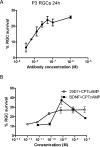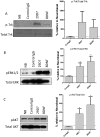Neurotrophic effect of a novel TrkB agonist on retinal ganglion cells
- PMID: 19875669
- PMCID: PMC2868417
- DOI: 10.1167/iovs.09-4450
Neurotrophic effect of a novel TrkB agonist on retinal ganglion cells
Abstract
Purpose: Retinal ganglion cells (RGCs) die in glaucoma and virtually all optic neuropathies. Recently, novel tropomyosin-related kinase B (TrkB) monoclonal antibodies have been shown to activate TrkB receptors and exert neuroprotective and neurotrophic effects. In the present study, the authors examined the ability of one of them, 29D7, to elicit RGC survival and neurite growth both in culture and in vivo.
Methods: RGCs from postnatal day (P)3 to P4 Sprague-Dawley rats were isolated by sequential immunopanning using a monoclonal antibody to Thy1. RGCs were cultured in serum-free defined medium in 96-well plates. RGC viability was assessed after 1 to 3 days by MTT assay. Activation of TrkB and downstream signaling molecules was confirmed by Western blot analysis. Intravitreal injections of 29D7 were performed after optic nerve axotomy, and subsequent RGC survival was quantified using beta-III tubulin immunostaining. Regeneration was assessed using retrograde fluorogold tracing in an optic nerve-peripheral nerve graft model.
Results: Similar to brain-derived neurotrophic factor (BDNF), the 29D7 antibody strongly promoted RGC survival and neurite growth in vitro compared with medium alone or control IgG. Forskolin, which weakly supported RGC survival on its own, potentiated the effect of 29D7. Intravitreal injection of 29D7 enhanced RGC survival but not regeneration in vivo 2 weeks after optic nerve injury.
Conclusions: Together, these findings demonstrate the potential for antibody-mediated TrkB agonism as a potential therapeutic approach to enhance RGC survival after optic nerve injury. Further studies are needed to elucidate the mechanistic differences between this TrkB agonist and BDNF.
Figures






Similar articles
-
A Small Molecule TrkB Neurotrophin Receptor Partial Agonist as Possible Treatment for Experimental Nonarteritic Anterior Ischemic Optic Neuropathy.Curr Eye Res. 2018 Dec;43(12):1489-1499. doi: 10.1080/02713683.2018.1508726. Epub 2018 Oct 1. Curr Eye Res. 2018. PMID: 30273053 Free PMC article.
-
An agonistic TrkB mAb causes sustained TrkB activation, delays RGC death, and protects the retinal structure in optic nerve axotomy and in glaucoma.Invest Ophthalmol Vis Sci. 2010 Sep;51(9):4722-31. doi: 10.1167/iovs.09-5032. Epub 2010 Mar 31. Invest Ophthalmol Vis Sci. 2010. PMID: 20357199
-
Effects of axotomy and intraocular administration of NT-4, NT-3, and brain-derived neurotrophic factor on the survival of adult rat retinal ganglion cells. A quantitative in vivo study.Invest Ophthalmol Vis Sci. 1996 Mar;37(4):489-500. Invest Ophthalmol Vis Sci. 1996. PMID: 8595949
-
Synergistic effects of osteonectin and brain-derived neurotrophic factor on axotomized retinal ganglion cells neurite outgrowth via the mitogen-activated protein kinase-extracellular signal-regulated kinase 1/2 pathways.Neuroscience. 2010 Jan 20;165(2):463-74. doi: 10.1016/j.neuroscience.2009.10.026. Neuroscience. 2010. PMID: 19837135
-
TrkB agonist antibody pretreatment enhances neuronal survival and long-term sensory motor function following hypoxic ischemic injury in neonatal rats.PLoS One. 2014 Feb 14;9(2):e88962. doi: 10.1371/journal.pone.0088962. eCollection 2014. PLoS One. 2014. PMID: 24551199 Free PMC article.
Cited by
-
Dual Specific Phosphatase 14 Deletion Rescues Retinal Ganglion Cells and Optic Nerve Axons after Experimental Anterior Ischemic Optic Neuropathy.Curr Eye Res. 2021 May;46(5):710-718. doi: 10.1080/02713683.2020.1826976. Epub 2020 Oct 27. Curr Eye Res. 2021. PMID: 33107352 Free PMC article.
-
Optic nerve regeneration: A long view.Restor Neurol Neurosci. 2019;37(6):525-544. doi: 10.3233/RNN-190960. Restor Neurol Neurosci. 2019. PMID: 31609715 Free PMC article. Review.
-
The Krüppel-Like Factor Gene Target Dusp14 Regulates Axon Growth and Regeneration.Invest Ophthalmol Vis Sci. 2018 Jun 1;59(7):2736-2747. doi: 10.1167/iovs.17-23319. Invest Ophthalmol Vis Sci. 2018. PMID: 29860460 Free PMC article.
-
Neuroprotective strategies for retinal disease.Prog Retin Eye Res. 2018 Jul;65:50-76. doi: 10.1016/j.preteyeres.2018.02.002. Epub 2018 Feb 23. Prog Retin Eye Res. 2018. PMID: 29481975 Free PMC article. Review.
-
Neurodegeneration as a primary change and role of neuroprotection in diabetic retinopathy.Mol Neurobiol. 2015;51(3):878-84. doi: 10.1007/s12035-014-8732-7. Epub 2014 May 15. Mol Neurobiol. 2015. PMID: 24826918 Review.
References
-
- Quigley HA, Nickells RW, Kerrigan LA, Pease ME, Thibault DJ, Zack DJ. Retinal ganglion cell death in experimental glaucoma and after axotomy occurs by apoptosis. Invest Ophthalmol Vis Sci 1995;36:774–786 - PubMed
-
- Mey J, Thanos S. Intravitreal injections of neurotrophic factors support the survival of axotomized retinal ganglion cells in adult rats in vivo. Brain Res 1993;602:304–317 - PubMed
-
- Cui Q, Lu Q, So KF, Yip HK. CNTF, not other trophic factors, promotes axonal regeneration of axotomized retinal ganglion cells in adult hamsters. Invest Ophthalmol Vis Sci 1999;40:760–766 - PubMed
-
- Parrilla-Reverter G, Agudo M, Sobrado-Calvo P, Salinas-Navarro M, Villegas-Perez MP, Vidal-Sanz M. Effects of different neurotrophic factors on the survival of retinal ganglion cells after a complete intraorbital nerve crush injury: a quantitative in vivo study. Exp Eye Res 2009;89:32–41 - PubMed
Publication types
MeSH terms
Substances
Grants and funding
LinkOut - more resources
Full Text Sources
Other Literature Sources
Miscellaneous

